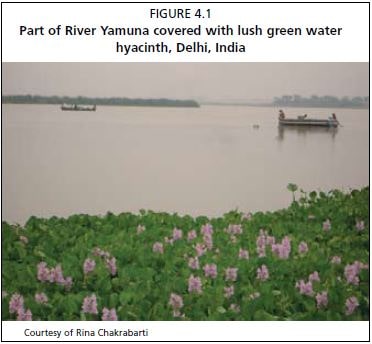4. Floating aquatic macrophytes – Water hyacinths
Mature plants of water hyacinths (Eichhornia crassipes) consist of long, pendant roots, rhizomes, stolons, leaves, inflorescences and fruit clusters. The plants may be up to 1 m high, although 40 cm is the more usual height. The inflorescence bears 6-10 lily-like flowers, each 4-7 cm in diameter.
The stems and leaves contain air-filled tissue, which gives the plant considerable buoyancy. Vegatative reproduction takes place at a rapid rate under preferential conditions (Herfjord, Osthagen and Saelthun, 1994).
Water hyacinths are considered as nuisance species because they multiply rapidly and clog lakes, rivers and ponds. The thick mats (Figure 4.1) formed
Figure 4.1
Part of River Yamuna covered with lush green water hyacinth, Delhi, India

Courtesy of Rina Chakrabarti
under favourable conditions often obstruct fishing, shipping and irrigation and are hard to eradicate. Great efforts are being made to contain water hyacinths but, on the other hand, attempts are being made to find practical uses for the large biomass that is available. It offers the potential for use as fodder for domestic animals, as fish feed, for the production of biogas and for the removal of heavy metals and phenols from polluted waters. For example, studies have shown that about 1 million L/day of domestic sewage could be treated over an area of 1 ha through water hyacinths, reducing the BOD and COD by 89 and 71 percent, respectively (Reddy et al., 2005).
4.1 Classification
There are seven species of water hyacinth, the best known being the common water hyacinth, Eichhornia crassipes, which is a perennial free
floating aquatic plant belonging to the family Pontederiaceae (Figure 4.2).